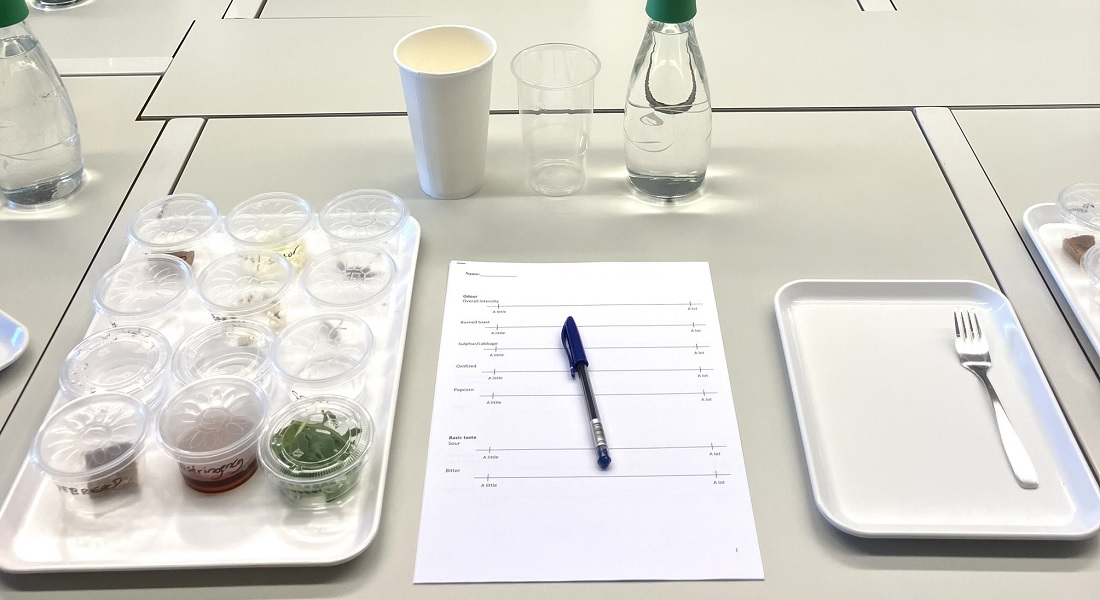Making energy bars from rapeseed side streams
Sensory scientists from Department of Food Science have recently tested a variety of energy bars made with rapeseed press cake, potentially marking the beginning of using the plentiful but inedible plant as a game-changing future protein source.

Half of all plant protein produced in the EU comes from rapeseed plants, but up until this point, its use for human consumption has been restricted to oil. The press cake that is left after the oil has been extracted is primarily used as animal feed, despite having a protein content of 30-40%, mainly due to its extremely bitter and pungent taste.
However, that underutilization may be about to change. Andrea Bononad Olmo and Wender Bredie from Department of Food Science have collaborated with the food research center, Spora, on using rapeseed press cake as a primary ingredient in a variety of energy bars and have just concluded a sensory evaluation of them with a trained panel.
“Working with rapeseed press cake is quite a sensory challenge, because it has some really strong bitter and pungent off-flavours. The sensory evaluation is key to understand the flavour contribution of the rapeseed press cake when incorporated into food products from the perspective of the consumers. For this initial sensory evaluation, we’ve focused on a specific tasty recipe that we then modified with varying concentrations of rapeseed press cake to observe sensory changes across formulations,” explains Andrea Bononad Olmo.
The development of the energy bars has been done through Green Solutions Centre (GSC) pilot project ‘From feed to Food – what does it take to make us eat rapeseed press cake.’ The product of the rapeseed press cake has gone through several iterations, ranging from spiced seasoning powders to juicy fermented meat alternatives, but ultimately landed on energy bars with a mix of fruits, seeds, and the rapeseed press cake.
Consumer’s willingness is key
For the sensory evaluation, the researchers created seven different samples from the baseline tasty recipe with increasing concentrations of rapeseed press cake, which they used to train the expert sensory panel, focusing on odor, taste, flavour, mouthfeel and aftertaste. The results of these tests will be used to further offset the characteristic bitterness and astringency of the press cake and develop a delicious end product.
Early results from the sensory panel show big sensory differences between the different formulations. Burnt and sour notes, hints of ryebread and popcorn were the most surprising attributes drawn out by the assessors. Its distinctive sharp pungency, linked to its sulfur compounds, was associated with cabbage and mustard-like flavors.
Both the treatment of the seeds before being pressed, and the concentration of pressed cake included in the formulation seem to have a real impact on the perceived unpleasant features. Lower concentrations, as hypothesized, had significantly milder off-flavors such as bitterness and astringency, positively influencing the overall intensity of the end product – all important information to secure the future success of using rapeseed press cake as protein for human consumption.
“Making the press cakes edible can be an important innovation for more sustainable food consumption in the future, but that will only be possible if it’s enjoyable for the consumers. That’s why sensory science is such an important part of this process – it drives product success. The perspectives that we get from the sensory panel are crucial, as they provide concrete, unbiased, and systematic feedback on specific sensory attributes for each sample. This is providing the initial critical insights that will drive consumer acceptance, liking, and purchase intent of the food product,” says Andrea Bononad Olmo.
Nutritional game changer
The energy bars and sensory evaluation is part of a larger project on transforming rapeseed side streams into food fit for human consumption, primarily conducted by our colleagues at the Department of Plant and Environmental Sciences, with Professor Barbara Halkier and Dr. Deyang Xu at the forefront.
And making rapeseed press cake edible is a nutritional game changer. They contain 30-40% protein, dietary fibers and even have an excellent amino acid profile but has remained unexploited as human food due to its anti-nutritional glucosinolates, which impart a harsh bitter taste, and is unhealthy for humans in too big quantities. But just last year, Deyang Xu, Barbara Halkier and colleagues published a paper identifying the proteins that help store the bitter substances in seeds of thale cress, a model plant and relative of rapeseed.
That discovery, which was published in Nature, opens the possibility that in the future it may be possible to breed rapeseed cultivars with even fewer glucosinolates in the seed. In anticipation of that future, the GSC pilot project aims to investigate what it will take to make rapeseed press cake a novel food, which has led to this week’s sensory evaluation in our SenseLab.
“This is a success story thanks to great collaboration across multiple disciplines, each addressing different critical points of the value chain. From the analytical quantification of the bitter compound, to addressing sensory challenges, understanding consumer preferences, and exploring its culinary potential by designing the most delicious food formulations – every step has been crucial. It’s a testament to the power of interdisciplinary teamwork and persistence in overcoming complex challenges,” says Andrea Bononad Olmo.
Contact
Andrea Bononad Olmo
Research Assistant
andrea.olmo@food.ku.dk
Wender Bredie
Professor
wb@food.ku.dk
